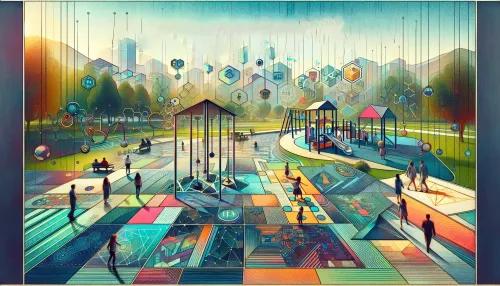
Navigating the Technological Evolution in Autism Support: Old Tools vs. New Innovations

Technology has been pivotal in shaping the landscape of support and assistance for individuals on the autism spectrum. From early assistive devices to cutting-edge wearable technologies, the evolution in this field has been remarkable. As we embark on a journey through the ever-expanding realm of technological advancements, it's clear that the future holds immense promise for enhancing the lives of autistic children through innovative solutions.
Tracing the Arc from Early Assistive Devices to Cutting-Edge Wearable Technologies
The yesteryears saw the emergence of rudimentary assistive devices aimed at aiding autistic children in their daily lives. These early tools, though groundbreaking in their time, were limited in their capabilities. Fast forward to the present day, and we are witnessing a paradigm shift with the advent of cutting-edge wearable technologies specifically designed to cater to the unique needs of autistic individuals. The "HorizonsMind Blog" delves into this transformative journey, shedding light on how these modern innovations are revolutionizing the support system for autistic children.
Enhancing Communication for Non-Verbal Children: From PECS to AAC Devices with AI Features
Communication lies at the heart of human interaction, serving as a fundamental element in our daily lives. For non-verbal children on the autism spectrum, expressing themselves effectively can be a daunting challenge. Historically, Picture Exchange Communication System (PECS) was relied upon as a valuable tool for augmenting communication skills. However, with advancements in technology, augmentative and alternative communication (AAC) devices equipped with AI features are paving new avenues for enhanced communication experiences. Exploring this evolution, offering insights into how these innovative devices are reshaping the communicative abilities of non-verbal autistic children.
The Integration of Virtual Reality for Immersive Learning Experiences in Autism Education
Virtual reality (VR) has transcended its entertainment roots and found meaningful application in education and therapy, particularly for individuals on the autism spectrum. The immersive nature of VR environments has been harnessed to create tailored learning experiences that cater to the unique cognitive characteristics of autistic individuals. From simulating real-world scenarios to facilitating social skills training, virtual reality is redefining the landscape of autism education. Within this context, we unravel the potential of VR as a transformative tool in providing immersive learning experiences for autistic children.
Understanding Sensory Integration Tools: From Basic Sensory Rooms to Advanced Sensory Wearables
Sensory integration plays a crucial role in the lives of autistic children, influencing their perception and interaction with the world around them. Early interventions featured basic sensory rooms designed to provide controlled sensory stimuli. However, contemporary advancements have given rise to advanced sensory wearables that offer personalized sensory modulation experiences, tailored to meet the specific needs of each child. "HorizonsMind Blog" dissects this progression, elucidating how these modern sensory integration tools are reshaping the support framework for autistic individuals by offering personalized sensory experiences.
The Role of Mobile Apps: Transitioning from Basic Educational Games to Tailored Therapeutic Initiatives
Mobile applications have undergone a profound transformation in catering to the diverse needs of autistic children. From basic educational games aimed at skill development to sophisticated therapeutic initiatives designed to address specific challenges associated with autism, mobile apps have emerged as invaluable tools in supporting autistic individuals. As we delve into this transition, highlighting how mobile apps are evolving to deliver tailored therapeutic interventions that aid in addressing diverse aspects of autism spectrum disorders.
How IoT is Creating Smarter Living Environments for Those on the Spectrum
The Internet of Things (IoT) has paved the way for creating smarter living environments that are conducive to meeting the unique requirements of individuals on the autism spectrum. IoT-enabled devices and systems are orchestrating a paradigm shift by offering personalized and adaptive solutions that cater to the sensory sensitivities and behavioral patterns exhibited by autistic individuals. In an exploration of this domain, as we elaborate on how IoT is revolutionizing living spaces for those on the spectrum by creating environments that promote comfort, safety, and autonomy.
Empowering Autistic Children Through Biofeedback and Neurofeedback Technologies
Biofeedback and neurofeedback technologies have emerged as potent tools in empowering autistic children by offering avenues for self-regulation and behavioral modulation. These innovative technologies provide real-time feedback on physiological and neural responses, enabling individuals on the autism spectrum to develop self-awareness and regulate their cognitive and emotional states. In an insightful analysis.
Reimagining Safety and Independence with GPS Technology and Smart Jewelry
Safety and independence are paramount considerations for caregivers of autistic children. The integration of GPS technology and smart jewelry presents a transformative proposition by offering real-time location tracking and safety assurance mechanisms. These innovations not only provide peace of mind to caregivers but also extend newfound independence to autistic individuals within safe parameters.
In conclusion, as we stride forward into a future adorned with technological marvels, it's evident that the trajectory of support for autistic children is undergoing a profound evolution shaped by innovation. The "HorizonsMind Blog" invites you to embark on this enlightening journey through time, exploring how old tools have seamlessly metamorphosed into new innovations that hold tremendous promise in enriching the lives of those on the autism spectrum.


